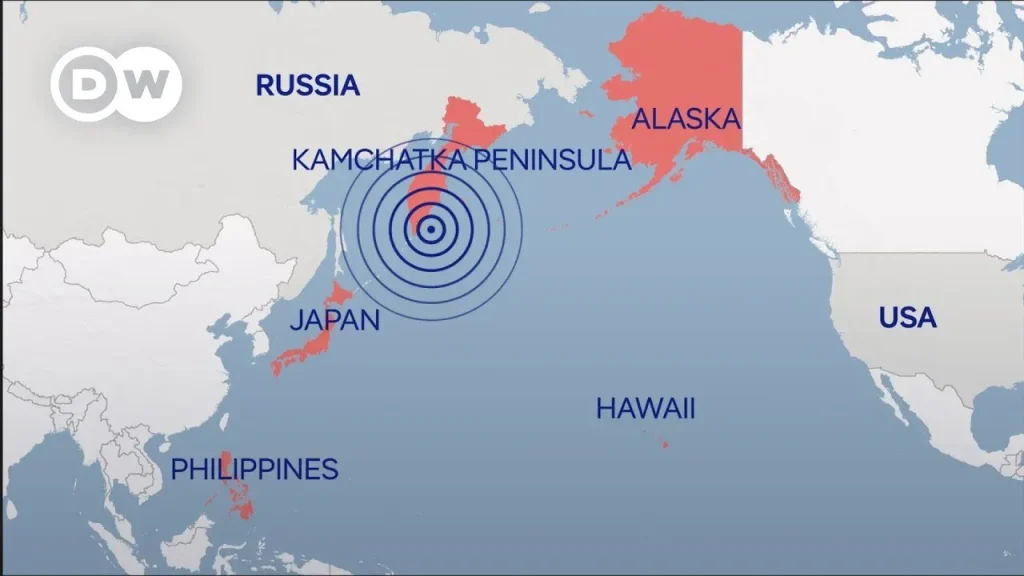Tsunami warnings have sent shockwaves across the Pacific following a catastrophic 8.8 magnitude earthquake off Russia’s Kamchatka Peninsula. This seismic activity has triggered mandatory evacuations in Japanese coastal towns and led to precautionary measures in Hawaii, where an evacuation order has been issued for residents living near the shore. Emergency Management Agencies are working tirelessly to monitor the situation, with officials closing harbors and advising residents to seek higher ground. Meanwhile, the alarming reports of tsunami waves exceeding three meters in Severo-Kurilsk highlight the immediate dangers facing communities in the affected areas. As the world watches, Pacific tsunami alerts remind us of the urgent need for preparedness in the face of natural disasters.
In the wake of seismic disturbances, alerts for potential tidal waves are pivotal for public safety. Following significant geological events, such as the recent earthquake affecting various regions, both local officials and international organizations have been on high alert. Communities are urged to implement evacuation protocols, particularly in vulnerable coastal areas with high accessibility for natural disasters. The urgency for appropriate safety measures, highlighted by alerts from Japan and Hawaii, underscores the importance of remaining informed and prepared for sudden natural events that can have far-reaching impacts.
Tsunami Warning Issued Following Major Earthquake
A significant tsunami warning was issued across the Pacific region after a powerful earthquake measuring 8.8 on the Richter scale struck near the Kamchatka Peninsula in Russia. This has raised alarms in multiple countries, including Japan and Hawaii, as they prepare for potential tsunami impacts. Authorities are urging residents in coastal areas to remain vigilant and to follow evacuation orders if issued. The recent seismic activity has underscored the importance of having emergency plans in place for unexpected natural disasters.
In response to the tsunami alert, local governments have activated emergency protocols to ensure public safety. Hawaii’s Emergency Management Agency, for instance, has advised residents to evacuate low-lying coastal areas, while residents of Japan have received alerts urging them to leave vulnerable regions immediately. The impact of such warnings can lead to significant disruption; commercial harbors have been closed, and air travel has been heavily impacted as flights are canceled to ensure the public’s safety.
Evacuations in Japan and Hawaii: A Response to Tsunami Alerts
Evacuations have been ordered in Japan, as officials sounded tsunami alerts following the earthquake in Kamchatka. Countries across the Pacific are mobilizing emergency services to facilitate safe evacuations and inform the public. In areas like Kanagawa prefecture, authorities are actively clearing beaches and advising beachgoers to leave immediately. The urgency of the situation is evident, with reports of congestion in evacuation routes as people rush to safety.
Similarly, Hawaii has issued an evacuation order, particularly advising residents in taller buildings to seek refuge on higher floors. With tsunami waves anticipated to exceed three meters, preparedness efforts are crucial. The Emergency Management Agency is coordinating with law enforcement and rescue teams to ensure that all residents, including visitors, are aware of the evacuation routes and safety measures in place.
Impact of the Kamchatka Earthquake on Tsunami Alerts
The recent Kamchatka earthquake generated significant tsunami waves, exceeding three meters, impacting coastal regions of Russia and sending ripples across the Pacific. First responders and emergency personnel are on high alert, as the extent of the tsunami’s reach could potentially affect nearby countries such as Japan and the Hawaiian Islands. Scientists are closely monitoring oceanic activity, using advanced technologies to assess changing wave patterns and the likelihood of further seismic activity.
Amidst the chaos, the international community is reminded of the interconnected nature of seismic events and tsunami warnings. Timely alerts can save lives, highlighting the need for robust communication systems among nations to share critical information. The rapid response regarding tsunami warnings following the earthquake demonstrates a concerted effort to mitigate risk and enhance regional disaster preparedness against future seismic threats.
The Pacific Tsunami Warning Center is actively disseminating information and updates to affected regions, reinforcing the significance of preparedness measures such as tsunami drills and community awareness programs. By understanding the potential risks associated with earthquakes and tsunamis, residents can better protect themselves and take preventative actions during such emergencies.
Hawaii’s Evacuation Orders amid Tsunami Threat
In Hawaii, the state has taken proactive measures to ensure public safety in light of the tsunami threat triggered by the earthquake in Kamchatka. Governor Josh Green has declared a state of emergency, and all commercial harbors in the state have been ordered to close. Residents living in low-lying areas are urged to evacuate to higher ground, as emergency services prepare for the arrival of waves expected to inundate coastal regions.
The Emergency Management Agency has established temporary shelters and deployed resources to assist those displaced by the impending tsunami. With flights canceled and transportation routes crowded, community organizations are mobilizing to provide essential services and support to those in need, ensuring that safety protocols are followed diligently. The collaborative efforts showcase the resilience of the Hawaiian spirit as residents come together to confront this potential natural disaster.
Japan’s Emergency Measures Following Tsunami Alerts
In Japan, the government is swiftly implementing emergency measures in response to tsunami alerts and evacuation orders following the earthquake’s aftermath. Authorities have mobilized local law enforcement and emergency management teams to assist with evacuations along the Pacific coast, where waves are predicted to be significant. The Japan Meteorological Agency is actively monitoring seismic activity and issuing periodic updates, emphasizing the need for residents to stay informed.
Amidst the emergency protocols, major industries, including automakers such as Nissan, have suspended operations at factories to prioritize worker safety. This proactive approach highlights the potential economic impacts of natural disasters, emphasizing the importance of maintaining emergency preparedness even for critical infrastructure. The focus remains on safeguarding lives while assessing the potential damage and recovery plans in the wake of the tsunami alerts.
The Role of Technology in Tsunami Predictions and Warnings
Technology plays a pivotal role in enhancing tsunami predictions and warnings, especially in light of the recent Kamchatka earthquake. Advanced seismic monitoring systems, satellite data, and ocean buoys contribute to real-time analysis of seismic activity and tsunami generation. These technological innovations allow for quicker and more accurate alerts, providing critical information to coastal communities at risk of tsunami events.
Moreover, the integration of social media and mobile applications has transformed how information is disseminated during emergencies. With instant updates and alerts being sent directly to residents, the potential for informed decision-making in crisis situations increases significantly. As communities face the threat of natural disasters, the reliance on technology to communicate risks and coordinate evacuations becomes more essential in ensuring public safety.
Understanding Earthquake Evacuations in Coastal Regions
Earthquake evacuations are a crucial aspect of disaster preparedness, particularly in coastal regions susceptible to tsunami events. The recent evacuation orders in Japan and Hawaii exemplify the importance of having clear protocols in place to protect residents from impending threats. These evacuations not only focus on physical safety but also on ensuring that residents understand the reasons behind them and the potential consequences of ignoring such warnings.
Emergency services conduct regular drills and public education campaigns to familiarize communities with evacuation routes and procedures. This proactive approach is essential in minimizing confusion and panic during an actual event. Understanding the dynamics of earthquakes and the subsequent risks of tsunamis enables residents to act decisively, thereby increasing their chances of safety during such unpredictable scenarios.
International Collaboration in Tsunami Preparedness
The recent events highlight the necessity for international collaboration in tsunami preparedness and response. Various countries across the Pacific, like Japan and Russia, must communicate and coordinate their efforts to mitigate risks associated with seismic activities. Shared resources, research data, and communication strategies enhance overall regional resilience against natural disasters, emphasizing the interconnectedness of coastal nations.
Countries involved in the Pacific Tsunami Warning System demonstrate how collective action can lead to better outcomes in the face of adversity. By participating in joint drills and information-sharing platforms, nations can refine their disaster response protocols and improve community awareness. Strengthening ties across borders is essential in the fight against nature’s unpredictability, ensuring that timely alerts can save lives and aid in swift evacuations.
Preparing for the Unknown: Community Readiness for Tsunamis
Community readiness is paramount when facing the threat of tsunamis following significant earthquakes. It is essential for residents in coastal areas to have a thorough understanding of tsunami risks and to participate in local preparedness initiatives. Educational campaigns can equip individuals with the knowledge needed to respond effectively during a tsunami warning, fostering a culture of readiness that can save lives.
Local agencies often offer workshops and training sessions that teach residents how to recognize tsunami warnings, identify evacuation routes, and create emergency plans for their families. By promoting active participation, communities can strengthen their collective response capabilities, ultimately reducing the potential impact of such natural disasters on lives and property.
Lessons Learned from Past Tsunami Events and Earthquake Preparedness
Past tsunami events provide valuable lessons for current preparedness efforts in mitigating the impacts of natural disasters. The world has witnessed numerous catastrophic tsunamis triggered by earthquakes, compelling nations to reevaluate their emergency management strategies. Each event raises awareness of the critical need for robust infrastructure, timely communication, and effective community engagement to handle similar challenges in the future.
Understanding the history of tsunami impacts enables communities to develop better response mechanisms. Research efforts aimed at analyzing past events help improve forecasting methods and evacuation procedures. By learning from previous experiences and implementing changes, communities can strengthen their resilience against future seismic threats, ensuring that they are better equipped to face such challenges head-on.
Frequently Asked Questions
What should I do during a tsunami warning in Hawaii?
During a tsunami warning in Hawaii, residents are advised to evacuate to higher ground, ideally to the fourth floor or above in buildings that are ten stories tall or more. The Emergency Management Agency has closed all commercial harbors. It is crucial to be aware that tsunami waves can arrive hours after an earthquake, so staying informed through local news and emergency services is important.
How does a tsunami warning alert work in Japan?
In Japan, tsunami warning alerts are issued by the Japan Meteorological Agency when seismic activity, such as an earthquake near the coast, suggests the possibility of tsunamis. Coastal towns receive alerts, prompting residents to evacuate to designated safe areas. It is essential for the public to follow evacuation orders promptly to ensure their safety.
What significance does the recent Kamchatka earthquake have on tsunami warnings?
The recent magnitude 8.8 earthquake off Russia’s Kamchatka Peninsula directly triggered tsunami warnings across the Pacific Ocean. As a result, evacuations were ordered in Japan, Hawaii, and Russia due to the high tsunami waves observed, prompting emergency services to issue alerts and close coastal areas.
How does Hawaii respond to tsunami threats?
Hawaii’s response to tsunami threats includes closing commercial harbors and advising coastal residents to evacuate upland. Emergency services provide guidance on moving to higher ground and monitor tsunami activity. Recently, evacuations were successfully implemented after tsunami warnings were issued following significant earthquakes.
What actions should coastal residents take following a tsunami warning in Pacific regions?
Coastal residents in Pacific regions should pay attention to tsunami warnings and heed evacuation orders when issued. During a tsunami warning, it is crucial to move away from the coastline to higher ground and remain informed through local authorities about the tsunami’s status and safety guidance.
| Key Points | Details |
|---|---|
| Magnitude 8.8 Earthquake | A powerful earthquake struck off the Kamchatka Peninsula in Russia. |
| Tsunami Waves Recorded | Tsunami waves over 3 meters high recorded in Severo-Kurilsk; some reached 5 meters. |
| Evacuation Orders | Evacuations ordered in Japan, Hawaii, and parts of Russia. |
| Hawaii Measures | Hawaii closed commercial harbors; residents advised to move to higher floors. |
| Japan’s Response | Japan issued evacuation alerts and sound tsunami warnings across coastal towns. |
| Flights Canceled | All flights in and out of Maui were canceled due to tsunami alerts. |
Summary
Tsunami warning has led to urgent evacuations and safety protocols across multiple regions including Japan, Hawaii, and Russia following a significant earthquake. The situation remains critical as authorities actively work to ensure public safety amid rising tsunami waves. Continuous updates will follow as the response unfolds.



